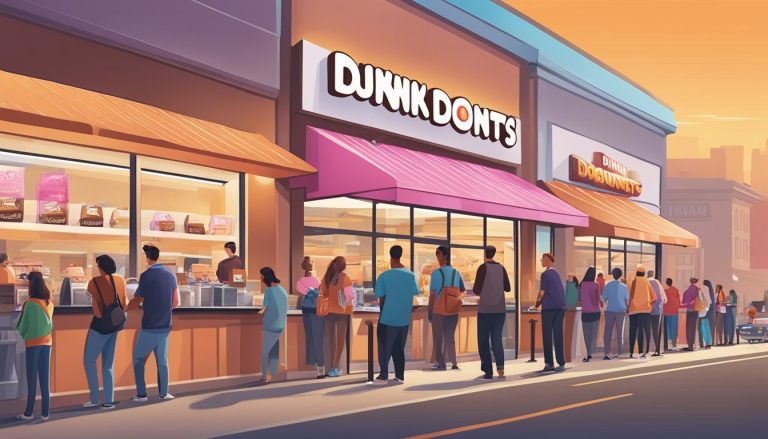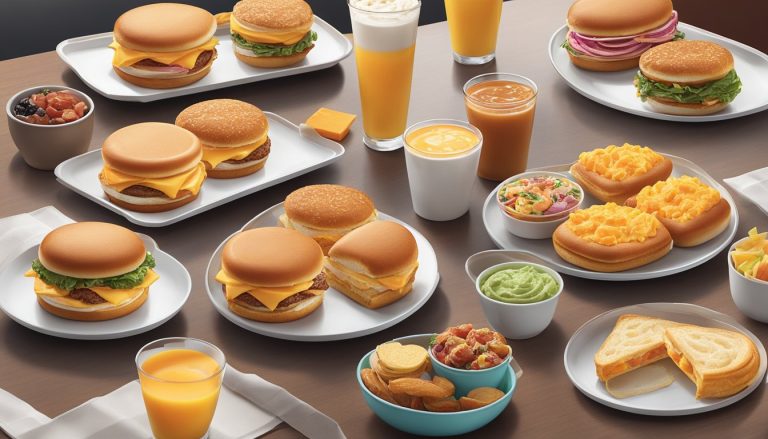Dunkin’, formerly known as Dunkin’ Donuts, has become a beloved staple in the world of coffee and breakfast treats. Since its inception, the brand has grown into a global phenomenon, serving millions of customers daily across thousands of locations worldwide.
While many are familiar with Dunkin’s signature coffee and donuts, there’s much more to this iconic brand than meets the eye. From its humble beginnings to its innovative menu offerings, Dunkin’ has a rich history filled with surprising facts and interesting tidbits that even the most devoted fans may not know. This article delves into 20 fun and intriguing facts about Dunkin’ that showcase the company’s journey, creativity, and enduring popularity.
1) Dunkin’ was originally named Open Kettle
Dunkin’ has a rich history that began in 1948 in Quincy, Massachusetts. The popular coffee and donut chain we know today started as a small food establishment called Open Kettle.
William Rosenberg, the founder, initially operated Open Kettle as a food truck. It served coffee, pastries, and sandwiches to local factory workers and construction crews.
The name Open Kettle reflected the cooking method used for preparing donuts at the time. After two years of operation, Rosenberg decided to rebrand the business.
In 1950, Open Kettle transformed into Dunkin’ Donuts. This new name emphasized the establishment’s focus on coffee and donuts, which had become its most popular offerings.
The rebranding proved successful, as Dunkin’ Donuts grew into a widely recognized chain. Today, the company is known simply as Dunkin’, but its origins as Open Kettle remain an interesting part of its history.
2) First location opened in Quincy, Massachusetts

The original Dunkin’ Donuts shop opened its doors in Quincy, Massachusetts in 1948. Founded by William Rosenberg, the establishment was initially called “Open Kettle.”
Located at 543 Southern Artery, this pioneering store offered a simple menu of coffee and donuts. Coffee sold for 10 cents a cup, while donuts cost 5 cents each.
Two years after its opening, Rosenberg renamed the shop “Dunkin’ Donuts.” This name change marked the beginning of what would become a global brand.
The Quincy location holds a special place in Dunkin’ history. It’s still in operation today, serving as a testament to the company’s enduring legacy.
Quincy, known as the birthplace of presidents John Adams and John Quincy Adams, now boasts another claim to fame as the hometown of Dunkin’ Donuts.
This first shop laid the foundation for Dunkin’s expansion. Within four years of opening, Rosenberg had established five locations, setting the stage for the brand’s future growth.
3) Serves over 3 million customers daily

Dunkin’ has established itself as a coffee and breakfast powerhouse, attracting a staggering number of customers each day. The chain serves more than 3 million people across its numerous locations worldwide.
This impressive daily customer count demonstrates Dunkin’s widespread popularity and appeal. It reflects the brand’s ability to consistently deliver products that resonate with a large and diverse customer base.
The high volume of daily customers also speaks to Dunkin’s efficiency in serving patrons quickly. Their streamlined processes and well-trained staff enable them to handle such a large influx of customers throughout the day.
This statistic underscores Dunkin’s significant market presence and its role as a go-to destination for coffee and breakfast items. It highlights the brand’s success in meeting the needs and preferences of millions of consumers on a daily basis.
4) Dunkin’ has over 50 varieties of donuts
Dunkin’ boasts an impressive array of donut options, with over 50 varieties available at any given time. This diverse selection caters to a wide range of tastes and preferences.
Customers can choose from classic favorites like glazed, chocolate frosted, and jelly-filled donuts. For those seeking unique flavors, Dunkin’ offers options such as blueberry cake and maple frosted.
The donut menu changes seasonally, introducing limited-time offerings to keep things interesting. This rotation ensures that customers always have something new to try alongside their familiar favorites.
Dunkin’s commitment to variety extends beyond just flavors. The chain offers different donut shapes and sizes, including traditional rings, filled donuts, and donut holes.
Despite rebranding to focus more on beverages, Dunkin’ maintains its dedication to providing a vast selection of donuts. This extensive range of options continues to be a significant draw for customers visiting Dunkin’ locations across the country.
5) Coffee sales make up 60% of their revenue

Dunkin’ may have started as a donut shop, but coffee has become their primary revenue driver. According to multiple sources, coffee and coffee-related products account for approximately 60% of Dunkin’s total sales.
This statistic highlights the company’s successful pivot towards becoming a beverage-focused brand. While donuts remain popular, Dunkin’ has effectively positioned itself as a major player in the competitive coffee market.
The emphasis on coffee is reflected in Dunkin’s menu offerings. They’ve expanded their coffee selection to include espresso-based drinks, iced coffees, and flavored options to cater to diverse consumer preferences.
Dunkin’s coffee dominance extends beyond in-store sales. The company has also seen growth in packaged coffee products sold in grocery stores, including K-cups and ground coffee. These retail offerings further contribute to their coffee-centric revenue stream.
6) The ‘Dunkin” logo was first created in 1960

The iconic Dunkin’ logo has a rich history dating back to 1960. This was a significant year for the company, as it marked the introduction of their first recognizable brand symbol.
The 1960 logo featured a circular design that cleverly incorporated both a donut and a coffee cup. The upper half of the circle was colored pink, representing a donut, while the lower half depicted a pink coffee cup.
This visual representation brilliantly captured the essence of Dunkin’s core offerings – donuts and coffee. It also introduced the now-famous pink color that has become synonymous with the brand.
The 1960 logo was a significant departure from the company’s original 1950 design. The earlier version used a simple dark crimson wordmark in a cursive script, resembling handwriting.
Dunkin’s 1960 logo laid the foundation for future iterations. It established key elements that would evolve over time, including the pink color scheme and the emphasis on both donuts and coffee in the visual branding.
7) The mascot’s name is Cuppy

Dunkin’ has an official mascot named Cuppy. This cheerful character takes the form of an anthropomorphic coffee cup, complete with a lid and straw.
Cuppy represents the brand’s fun and energetic personality. The mascot often appears at Dunkin’ events and store openings to interact with customers and spread cheer.
With a warm smile and friendly demeanor, Cuppy embodies Dunkin’s welcoming atmosphere. The mascot’s design incorporates the brand’s signature pink and orange colors.
Cuppy helps create memorable experiences for Dunkin’ fans. Children especially enjoy meeting and taking photos with the lovable mascot character during special promotions.
As a brand ambassador, Cuppy plays an important role in Dunkin’s marketing efforts. The mascot’s presence reinforces the company’s image as an approachable, everyday coffee destination.
8) First international location in Japan, 1970

Dunkin’ took a major step in its global expansion by opening its first international location in Japan in 1970. This move marked the beginning of the company’s presence beyond North American borders.
The Japanese market presented a unique opportunity for Dunkin’ to introduce its coffee and donut offerings to a new audience. The decision to expand to Japan demonstrated the company’s confidence in its brand and products.
By establishing a presence in Japan, Dunkin’ laid the groundwork for future international growth. This initial foray into overseas markets paved the way for the company’s expansion into other countries and continents.
The success of the Japanese location encouraged Dunkin’ to continue its global expansion efforts. Today, the company operates thousands of stores worldwide, serving customers across numerous countries and cultures.
9) Renamed from Dunkin’ Donuts to Dunkin’ in 2019
In early 2019, Dunkin’ Donuts made a significant branding change. The company officially dropped “Donuts” from its name, becoming simply “Dunkin’.”
This rebranding effort aimed to emphasize the chain’s wider range of offerings beyond donuts. Dunkin’ had evolved to become known for its coffee and breakfast items as much as its pastries.
The name change reflected a shift in consumer preferences and the company’s menu expansion. It also allowed Dunkin’ to present itself as a more versatile quick-service restaurant.
Despite the new name, Dunkin’ continued to sell its popular donuts. The rebranding was more about acknowledging the company’s broader identity and appeal to customers.
This move followed nearly 70 years of operating under the Dunkin’ Donuts name. The company maintained its familiar pink and orange color scheme and font style, ensuring brand recognition remained strong.
10) Introduced espresso beverages in 2003

Dunkin’ expanded its beverage offerings in 2003 by introducing espresso-based drinks to its menu. This move aimed to cater to customers seeking more sophisticated coffee options beyond traditional brewed coffee.
The addition of espresso beverages marked a significant shift in Dunkin’s product lineup. It allowed the company to compete more directly with specialty coffee shops and appeal to a broader range of coffee enthusiasts.
Jon Luther, who became CEO in January 2003, played a key role in bringing espresso drinks to Dunkin’. This decision reflected the company’s commitment to innovation and meeting changing consumer preferences.
The introduction of espresso beverages included popular options like lattes, cappuccinos, and Americanos. These new offerings provided customers with more choices to customize their coffee experience.
By incorporating espresso-based drinks, Dunkin’ positioned itself as a more versatile coffee destination. This strategic move helped the company maintain its relevance in the evolving coffee market and attract new customers seeking premium coffee options.
11) Its coffee cups are made from polypropylene

Dunkin’ uses polypropylene, a type of plastic, for its coffee cup lids. This material is commonly identified as plastic #5 in recycling systems.
Polypropylene offers several advantages for beverage containers. It’s durable, heat-resistant, and helps keep drinks at the desired temperature.
Unfortunately, the use of polypropylene in coffee cups presents recycling challenges. Most recycling facilities cannot process these cups due to their mixed material composition.
The plastic lids can take hundreds of years to decompose in landfills. This longevity contributes to environmental concerns about single-use plastics.
Dunkin’ has recognized these issues and is working on more sustainable packaging options. The company aims to reduce its environmental impact while maintaining product quality.
Customers can help by using reusable cups when possible. This simple action can significantly decrease the number of disposable cups entering the waste stream.
12) Seasonal flavors include Pumpkin Spice

Dunkin’ embraces seasonal flavors, with Pumpkin Spice being a popular autumn offering. The chain typically introduces its fall menu in late August, featuring a variety of pumpkin-themed items.
Pumpkin Spice lattes and coffees are staples of Dunkin’s seasonal lineup. These beverages combine the warm flavors of cinnamon, nutmeg, ginger, and cloves to create the signature pumpkin spice taste.
In addition to drinks, Dunkin’ often offers pumpkin-flavored donuts and muffins during the fall season. These baked goods complement the pumpkin beverages and cater to customers seeking a full autumn-themed experience.
Dunkin’ has expanded its seasonal offerings beyond in-store items. The company now produces Pumpkin Spice flavored coffee for at-home brewing, allowing customers to enjoy the taste year-round.
The popularity of Pumpkin Spice has led Dunkin’ to explore other seasonal flavors. Winter often brings Peppermint Mocha options, showcasing the brand’s commitment to providing varied, season-appropriate choices for its customers.
13) Offers mobile ordering through their app

Dunkin’ embraces technology to enhance customer convenience. The company’s mobile app allows customers to place orders ahead of time for quick pickup.
This feature, called On-the-Go Mobile Ordering, enables guests to skip the line when they arrive at the store. Customers can also use the drive-thru for mobile order pickup.
The app integrates with Dunkin’s DD Perks rewards program. Members can earn points on their purchases regardless of payment method, including credit, debit, cash, or gift cards.
Dunkin’s mobile app offers additional features beyond ordering. It includes a store locator to find nearby locations and mobile payment options for faster checkout.
The app also provides exclusive offers to DD Perks members. This combination of features aims to streamline the Dunkin’ experience for customers on the go.
14) Regularly partners with other brands for flavors

Dunkin’ frequently collaborates with popular brands to create unique and exciting flavor combinations. These partnerships allow the company to offer limited-time menu items that generate buzz and attract customers.
One notable collaboration was with Girl Scouts of the USA. Dunkin’ introduced coffee flavors inspired by Girl Scout Cookies, such as Thin Mints, Coconut Caramel, and Peanut Butter Cookie.
The company also teamed up with Hershey’s to create a series of chocolate-themed beverages and donuts. This partnership brought flavors like Kit Kat Coolatta and Heath donut to Dunkin’ locations.
In another flavor crossover, Dunkin’ joined forces with Baskin-Robbins to incorporate popular ice cream flavors into their menu. This resulted in items like the Baskin-Robbins Mint Chocolate Chip Frozen Coffee.
These brand partnerships allow Dunkin’ to stay innovative and tap into existing fan bases of other popular products. It’s a strategy that keeps customers coming back to try new and exciting flavor combinations.
15) Has an on-the-go loyalty program
Dunkin’ offers a convenient mobile app-based loyalty program called DD Perks. This program allows customers to earn points on their purchases, which can be redeemed for free beverages.
Members can accumulate 5 points for every dollar spent at Dunkin’ locations. Once they reach 200 points, they receive a free beverage reward of their choice.
The DD Perks program also provides exclusive offers and promotions to its members. Customers can easily track their points, rewards, and account activity through the mobile app.
One of the program’s standout features is On-the-Go Mobile Ordering. This allows members to place orders in advance and skip the line when picking up their items at participating locations.
DD Perks integrates seamlessly with Dunkin’s drive-thru service, enabling members to earn and redeem points even when ordering from their cars. This combination of convenience and rewards has made the program popular among Dunkin’ regulars.
16) Dunkin’ operates in over 40 countries

Dunkin’ has expanded far beyond its American roots, establishing a strong international presence. The beloved coffee and donut chain now operates in more than 40 countries across the globe.
This widespread reach allows people from diverse cultures to enjoy Dunkin’s signature offerings. From bustling cities to small towns, Dunkin’ shops can be found serving up fresh coffee and treats to customers worldwide.
The company’s global expansion strategy has proven successful. Dunkin’ has adapted its menu to cater to local tastes in different regions while maintaining its core products.
Some international locations feature unique menu items that reflect the local cuisine. This blend of familiar favorites and regional specialties has helped Dunkin’ gain popularity in various markets.
With thousands of stores spread across continents, Dunkin’ continues to grow its international footprint. The brand’s ability to resonate with consumers in different countries demonstrates its universal appeal.
17) Introduced ‘Coffee Coolatta’ in 1997

Dunkin’ launched the Coffee Coolatta in 1997 as a refreshing frozen beverage option. This innovative drink was created in response to the growing popularity of blended iced coffee drinks in the market.
The Coffee Coolatta quickly became a hit among Dunkin’ customers, offering a cool and creamy alternative to traditional hot coffee. It combined the rich flavor of coffee with a smooth, icy texture.
Over the years, Dunkin’ expanded the Coolatta line to include various flavors beyond coffee. Fruit-based options and classic flavors like vanilla were added to cater to different taste preferences.
The introduction of the Coffee Coolatta marked a significant milestone in Dunkin’s product innovation. It demonstrated the company’s ability to adapt to changing consumer trends and preferences in the beverage industry.
18) Acquired Baskin-Robbins in 2020 merger

Dunkin’ and Baskin-Robbins joined forces in a significant merger in 2020. Inspire Brands, a multi-brand restaurant company, acquired both chains in a massive $11.3 billion deal.
This acquisition brought together two iconic brands under one corporate umbrella. Dunkin’, known for its coffee and donuts, and Baskin-Robbins, famous for its ice cream, became part of a larger family of restaurant chains.
The merger was finalized in December 2020. It marked a new chapter for both Dunkin’ and Baskin-Robbins, integrating them into Inspire Brands’ portfolio of restaurants.
This move expanded Inspire Brands’ reach to nearly 32,000 restaurants across more than 60 countries. It combined Dunkin’s expertise in coffee and baked goods with Baskin-Robbins’ leadership in the ice cream category.
The acquisition aimed to leverage the strengths of both brands while providing opportunities for growth and innovation. It positioned Dunkin’ and Baskin-Robbins for continued success in the competitive food service industry.
19) Famous for ‘Munchkins’ donut holes
Dunkin’ introduced Munchkins donut holes in 1972, quickly becoming a fan favorite. These bite-sized treats are made from the dough cut out of the center of ring donuts.
Munchkins come in various flavors, including popular options like glazed, chocolate, and jelly-filled. Their small size makes them perfect for sharing and snacking on the go.
The name “Munchkins” is a clever reference to the small characters from L. Frank Baum’s “The Wonderful Wizard of Oz.” This playful branding has helped make these treats memorable and appealing to customers of all ages.
Munchkins are often sold in boxes of various quantities, allowing customers to mix and match flavors. They’ve become a popular choice for office meetings, parties, and other gatherings where people want a sweet, shareable snack.
Over the years, Munchkins have remained a staple of Dunkin’s menu, continuing to delight customers with their convenient size and tasty flavors. Their enduring popularity demonstrates Dunkin’s ability to create iconic products that stand the test of time.
20) Pioneered ready-to-drink bottled iced coffee
Dunkin’ revolutionized the coffee industry by introducing ready-to-drink bottled iced coffee. This innovative product allowed customers to enjoy their favorite Dunkin’ iced coffee flavors at home or on the go.
The company partnered with The Coca-Cola Company to manufacture and distribute these bottled beverages. This collaboration brought Dunkin’s signature taste to grocery stores, convenience stores, and mass merchandisers across the United States.
Dunkin’s ready-to-drink iced coffees are crafted using their signature Arabica beans. This ensures customers experience the same rich and smooth flavor they expect from Dunkin’ shops.
The bottled iced coffee line includes various flavors to suit different preferences. These beverages contain real milk and sugar, maintaining the authentic Dunkin’ taste.
Dunkin’ later expanded its at-home offerings to include multi-serve bottles of iced coffee. This allows customers to keep their favorite Dunkin’ beverages stocked in their refrigerators throughout the week.
History of Dunkin’
Dunkin’ has a rich history spanning over 70 years, evolving from a single shop to a global brand. The company’s journey is marked by innovation, expansion, and a commitment to serving coffee and donuts to millions of customers worldwide.
Origins and Founding
Dunkin’ was founded in 1950 by William Rosenberg in Quincy, Massachusetts. The first store, called “Open Kettle,” served coffee and donuts for 5 and 10 cents respectively. In 1955, the name changed to “Dunkin’ Donuts” after Rosenberg consulted with company executives.
Franchising began in 1955, with the 100th location opening in 1963. This rapid expansion solidified Dunkin’ as a major player in the quick-service restaurant industry.
Evolution Over the Decades
The 1970s and 1980s saw Dunkin’ introducing new products like muffins and breakfast sandwiches. In 1979, they opened their 1,000th restaurant.
In the 1990s, Dunkin’ expanded internationally, entering markets in Asia and Europe. The company launched its popular “America Runs on Dunkin'” slogan in 2006.
A significant rebranding occurred in January 2019 when “Dunkin’ Donuts” officially became “Dunkin’.” This change reflected the company’s focus on coffee and other beverages beyond donuts.
By 2025, Dunkin’ operates over 12,500 restaurants in 46 countries. The menu now includes a wide variety of coffee drinks, donuts, and food items, with an estimated 25,000 ways to customize coffee orders.
Dunkin’s Global Presence
Dunkin’ has expanded far beyond its American roots to become a global coffee and donut empire. Its international footprint spans dozens of countries, with unique menu offerings tailored to local tastes around the world.
International Expansion
Dunkin’ operates in 46 countries worldwide. The company has over 12,500 restaurants globally, including more than 9,000 in the United States. Its first international location opened in Canada in 1961.
Dunkin’ has a strong presence in Asia, with hundreds of stores in countries like South Korea, Thailand, and the Philippines. The brand entered the European market in the 1970s, starting with Germany.
Latin America has also embraced Dunkin’, with locations in countries such as Mexico, Chile, and Peru. The Middle East is another key region, with stores in Saudi Arabia, the UAE, and other Gulf nations.
Unique Offerings Around the World
Dunkin’ adapts its menu to suit local preferences in different countries. In India, stores offer spiced tea and vegetable-filled savory donuts. Chinese locations serve green tea flavored donuts and bubble tea.
South Korean Dunkin’ stores feature bulgogi (marinated beef) donuts and rice punch drinks. In Lebanon, customers can enjoy za’atar-spiced flatbreads. Japanese locations offer pon de ring donuts – small connected circles of dough.
In the Philippines, Dunkin’ serves local favorites like ensaymada (sweet bread) and mango-flavored donuts. Brazilian stores offer brigadeiro (chocolate truffle) and queijo (cheese) donuts to cater to local tastes.




